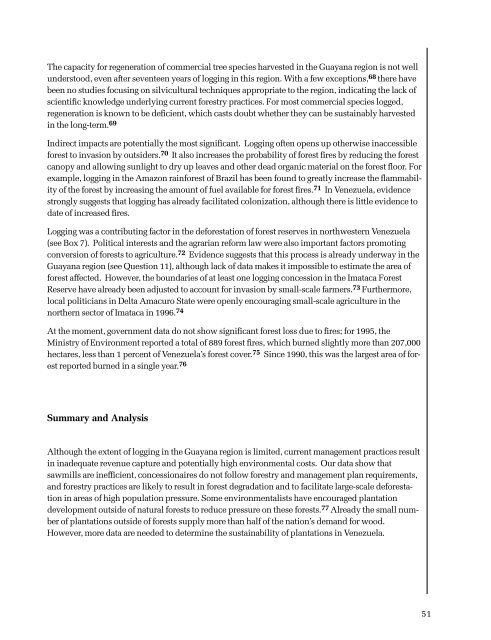Usar pâgs xvii-134 - ResearchGate
Usar pâgs xvii-134 - ResearchGate
Usar pâgs xvii-134 - ResearchGate
Create successful ePaper yourself
Turn your PDF publications into a flip-book with our unique Google optimized e-Paper software.
The capacity for regeneration of commercial tree species harvested in the Guayana region is not wellunderstood, even after seventeen years of logging in this region. With a few exceptions, 68 there havebeen no studies focusing on silvicultural techniques appropriate to the region, indicating the lack ofscientific knowledge underlying current forestry practices. For most commercial species logged,regeneration is known to be deficient, which casts doubt whether they can be sustainably harvestedin the long-term. 69Indirect impacts are potentially the most significant. Logging often opens up otherwise inaccessibleforest to invasion by outsiders. 70 It also increases the probability of forest fires by reducing the forestcanopy and allowing sunlight to dry up leaves and other dead organic material on the forest floor. Forexample, logging in the Amazon rainforest of Brazil has been found to greatly increase the flammabilityof the forest by increasing the amount of fuel available for forest fires. 71 In Venezuela, evidencestrongly suggests that logging has already facilitated colonization, although there is little evidence todate of increased fires.Logging was a contributing factor in the deforestation of forest reserves in northwestern Venezuela(see Box 7). Political interests and the agrarian reform law were also important factors promotingconversion of forests to agriculture. 72 Evidence suggests that this process is already underway in theGuayana region (see Question 11), although lack of data makes it impossible to estimate the area offorest affected. However, the boundaries of at least one logging concession in the Imataca ForestReserve have already been adjusted to account for invasion by small-scale farmers. 73 Furthermore,local politicians in Delta Amacuro State were openly encouraging small-scale agriculture in thenorthern sector of Imataca in 1996. 74At the moment, government data do not show significant forest loss due to fires; for 1995, theMinistry of Environment reported a total of 889 forest fires, which burned slightly more than 207,000hectares, less than 1 percent of Venezuela’s forest cover. 75 Since 1990, this was the largest area of forestreported burned in a single year. 76Summary and AnalysisAlthough the extent of logging in the Guayana region is limited, current management practices resultin inadequate revenue capture and potentially high environmental costs. Our data show thatsawmills are inefficient, concessionaires do not follow forestry and management plan requirements,and forestry practices are likely to result in forest degradation and to facilitate large-scale deforestationin areas of high population pressure. Some environmentalists have encouraged plantationdevelopment outside of natural forests to reduce pressure on these forests. 77 Already the small numberof plantations outside of forests supply more than half of the nation’s demand for wood.However, more data are needed to determine the sustainability of plantations in Venezuela.51
















